Indoor plant can be an excellent choice to make your house attractive and eye-catching. Besides, they create a natural atmosphere around you. For decorating your room or house tall indoor plants are the best choice because these plants will provide you fresh air and absorb carbon dioxide, particularly the rubber plant or fiddle leaf fig. Besides its very easy to take care of these plants. Let’s know about some tall indoor plants.
Monstera deliciosa :
Monstera deliciosa is a familiar indoor plant whose scientific name is Monstera deliciosa Liebm. But it is mostly known as Swiss Cheese Plant or split-leaf philodendron .It is mostly found in Mexico and Central America. The nature of this Plant is climbing. Generally, the height is 8-10 feet, but it depends on care and pot size. The size of the leaves is large, heart-shaped, with natural holes. It is glossy and deep green.
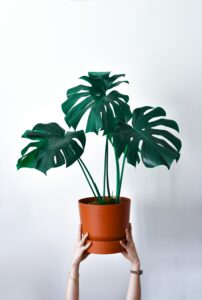
Where to find it?
Well,Generally it is found in home improvement stores and nurseries .Or you can order it from different e-commerce sites.
Benefits of having Monstera Deliosa:
- It purifies air and absorbs carbon dioxide.
- It releases moisture into the air, and as a result, the humidity increases.
- Has a vibrant look.
- Help to overcome stress reduction.
- Finally, maintenance is easy.
Common Issues :
- Yellow leaves.
- Attacked by pests like mealybugs, thrips, scale, or spider mites.
- Black or Brown Spots on Leaves.
- Leaves Curling.
Care Tips:
- It needs indirect sunlight and can survive in low light. So avoid direct sunlight.
- Generally, every 1-2 weeks, you can water it. Besides, your pot drainage system should be good.
- Avoid chlorinated water if possible.
- Try to mix soil that includes components like perlite, orchid bark, or pumice.
- Wipe the leaves with a damp cloth and remove dust.
- Trim damaged leaves and cut back stems.
- Examine the soil, roots, and leaves every week.
Toxicity: Monstera deliciosa is toxic to humans and pets. So keep it away from Haman, especially from children and Pets.
The Areca Palm :
The Areca Palm is a popular tall Indoor plant. It is scientifically known as Dypsis lutescens and belongs to the Arecaceae family. Its Alternative Names are the Butterfly Palm , Golden Cane Palm, Yellow Palm.
Benefits of Having Areca Palm:
- The growth of Areca is faster than normal.
- It increases the beauty and makes homes, offices, and public spaces elegant fronds.
- Its air purifying quality is also mentionable.
- It gives relaxation and reduces stress.
Common Issues:
- Brown Spots on Leaves
- Dropping Leaves
- Pests.
Care Tips:
- Place the Plant in a bright place and avoid direct sunlight
- Water it once a week in summer and every 2-3 times in winter.
- Keep the Plant somewhere where air does not enter directly.
- Wipe the leaves with a damp cloth to keep them healthy.
- Trim yellow, brown, or dead fronds if needed.
Toxicity: It’s nontoxic to humans and pets.
FIddle Leaf Fig :
FIddle Leaf is a Western African plant, widely known as Fiddle Leaf Fig, Banjo Fig. Its scientific name is Ficus lyrata. Its leaves is Large, lovely as well as glossy. They are shaped like a violin or “fiddle. Typically the length of these plants reach 6-10 feet.
Where to Find Fiddle Leaf Figs?
You can have it from your nearest local garden. You can also purchase it from online retailers. 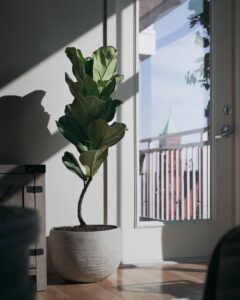
Benefits of having Fiddle Leaf Fig :
- Fiddle leaf helps to promote physical health; it boosts concentration and boosts mental well-being.
- Fiddle leaf figs clean the air and remove harmful chemicals.
- It can live for many years. So, it’s a long-time investment.
- It increases Humidity.
Common Issues :
- Brown Spots on Leaves
- Dropping Leaves
- Pests.
- Curling Leaves.
Care Tips:
- Try to keep it from direct sunlight.
- Make your pot drainage system good.
- Water once a week.
- Trim dead leaves and prune it
- You can wipe the leaves with a damp cloth to keep them dust-free.
Toxicity : Fiddle Leaf Fig is toxic to humans and pets. Because it contains calcium oxalate crystals. So, it may affect your skin.
Bird of paradise :
Bird of paradise plant is considered the queen of the house plant world. Its Scientific name is Strelitzia reginae, Widely known as Crane Flower. It is a tropical evergreen flowering plant. Its origin is in South Africa. The Bird of Paradise represents excitement, love, joyfulness, freedom, and anticipation. The leaves are Large and glossy green. They are paddle-shaped and similar to banana leaves. Indoors, it grows to around 5-7 feet.
Benefits of having Bird of Paradise : 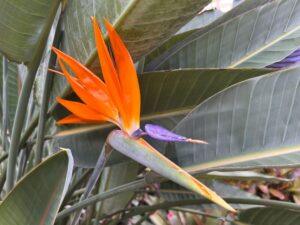
- Gives an aesthetic look to your house or office.
- It will improve Air quality.
- It’s nontoxic for humans and very easy to maintain.
- It has a long lifespan, and its leaves last for weeks.
- It boosts your mental health.
Common Issues :
- Dropping Leaves.
- Yellowing the leaves.
- Curling Leaves.
- Pests.
Care Tips:
- Bird of Paradise can tolerate direct light, like morning light.
- In spring and summer, it needs more water than in winter. Consistent watering is needed to keep the soil moist.
- Pruning and repotting are important for the perfect shape of a plant.
- You can prevent infestation if you wipe the leaves with a damp cloth regularly.
Toxicity : Though bird of Paradise isn’t toxic to humans, it is a little bit toxic to pets.
Rubber Plant:
The Rubber Plant is a well known houseplant which is native to southern China, Southeast Asia, and Indonesia. It belongs to the fig family, Moraceae. Ficus elastica is its scientific name. Its also known as the rubber fig, rubber bush, rubber tree, rubber plant, or Indian rubber bush, Indian rubber tree. It’s one of the familiar plants among all tall indoor plant.
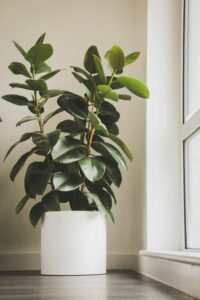
Benefits of Having a Rubber Plant :
- Absorbing carbon dioxide improves indoor air quality.
- Increase indoor Humidity.
- It has a natural Noise Absorption ability.
- It’s long-lasting, eco-friendly, and easy to maintain.
- It has Versatile Placement Options. You can keep it outside in warm climates.
Common Issues:
- Sap leakage
- Leaves not shiny
- Stunted growth
- Attack from Pests, like Spider mites, mealybugs, and scale.
Care Tips:
- This Plant loves to drink up the light, so placement in your home is crucial to maintaining a healthy plant
- Try to Rotate the Plant every few weeks. It will ensure the growth of the Plant.
- Water once a week or when 1–2 inches of soil is dry. Use filtered water if possible to avoid salt buildup.
- Pruning the stem and cleaning the leaves are good for keeping it healthy.
- Use insecticides to get rid of pests or bugs.
Toxicity : It’s harmful for Pets and especially for children. So keep the Plant out of reach of pets and young children.
Thus, Tall indoor plant not only give you an aesthetic look but also give you a more relaxing environment. Besides, these provide fresh air ,reduce your stress and bring natural beauty. Though these are indoor plants but they need minimal maintenance. A little effort is enough to achieve a good result; in addition, you can visit plantnursing.com for more suggestions. Start your green journey with tall indoor plant and enjoy the transformative impact they bring to your indoor spaces.
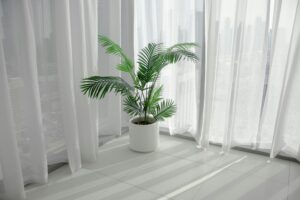
2 thoughts on “Tall Indoor Plant Ideas That Grow Easily with Less Care.”